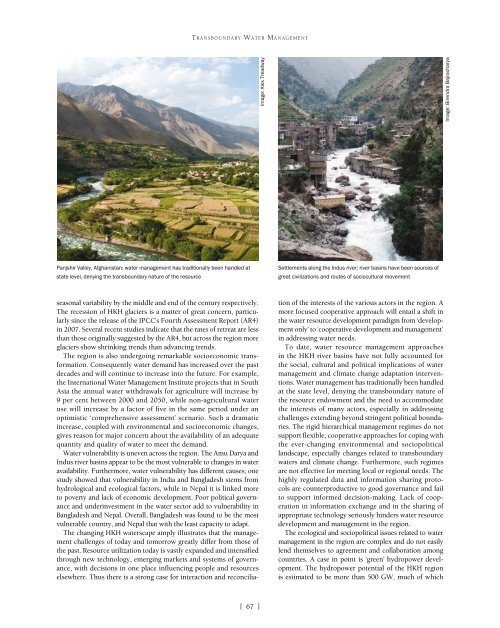222893e
222893e
222893e
You also want an ePaper? Increase the reach of your titles
YUMPU automatically turns print PDFs into web optimized ePapers that Google loves.
TRANSBOUNDARY WATER MANAGEMENTImage: Alex TreadwayImage: Birendra BajracharyaPanjshir Valley, Afghanistan: water management has traditionally been handled atstate level, denying the transboundary nature of the resourceSettlements along the Indus river: river basins have been sources ofgreat civilizations and routes of sociocultural movementseasonal variability by the middle and end of the century respectively.The recession of HKH glaciers is a matter of great concern, particularlysince the release of the IPCC’s Fourth Assessment Report (AR4)in 2007. Several recent studies indicate that the rates of retreat are lessthan those originally suggested by the AR4, but across the region moreglaciers show shrinking trends than advancing trends.The region is also undergoing remarkable socioeconomic transformation.Consequently water demand has increased over the pastdecades and will continue to increase into the future. For example,the International Water Management Institute projects that in SouthAsia the annual water withdrawals for agriculture will increase by9 per cent between 2000 and 2050, while non-agricultural wateruse will increase by a factor of five in the same period under anoptimistic ‘comprehensive assessment’ scenario. Such a dramaticincrease, coupled with environmental and socioeconomic changes,gives reason for major concern about the availability of an adequatequantity and quality of water to meet the demand.Water vulnerability is uneven across the region. The Amu Darya andIndus river basins appear to be the most vulnerable to changes in wateravailability. Furthermore, water vulnerability has different causes; onestudy showed that vulnerability in India and Bangladesh stems fromhydrological and ecological factors, while in Nepal it is linked moreto poverty and lack of economic development. Poor political governanceand underinvestment in the water sector add to vulnerability inBangladesh and Nepal. Overall, Bangladesh was found to be the mostvulnerable country, and Nepal that with the least capacity to adapt.The changing HKH waterscape amply illustrates that the managementchallenges of today and tomorrow greatly differ from those ofthe past. Resource utilization today is vastly expanded and intensifiedthrough new technology, emerging markets and systems of governance,with decisions in one place influencing people and resourceselsewhere. Thus there is a strong case for interaction and reconciliationof the interests of the various actors in the region. Amore focused cooperative approach will entail a shift inthe water resource development paradigm from ‘developmentonly’ to ‘cooperative development and management’in addressing water needs.To date, water resource management approachesin the HKH river basins have not fully accounted forthe social, cultural and political implications of watermanagement and climate change adaptation interventions.Water management has traditionally been handledat the state level, denying the transboundary nature ofthe resource endowment and the need to accommodatethe interests of many actors, especially in addressingchallenges extending beyond stringent political boundaries.The rigid hierarchical management regimes do notsupport flexible, cooperative approaches for coping withthe ever-changing environmental and sociopoliticallandscape, especially changes related to transboundarywaters and climate change. Furthermore, such regimesare not effective for meeting local or regional needs. Thehighly regulated data and information sharing protocolsare counterproductive to good governance and failto support informed decision-making. Lack of cooperationin information exchange and in the sharing ofappropriate technology seriously hinders water resourcedevelopment and management in the region.The ecological and sociopolitical issues related to watermanagement in the region are complex and do not easilylend themselves to agreement and collaboration amongcountries. A case in point is ‘green’ hydropower development.The hydropower potential of the HKH regionis estimated to be more than 500 GW, much of which[ 67 ]


